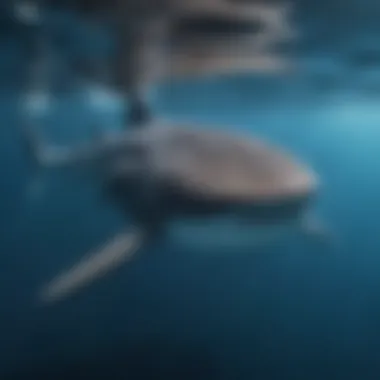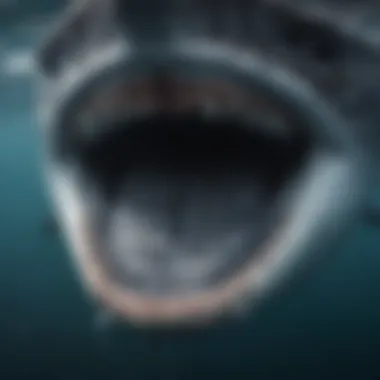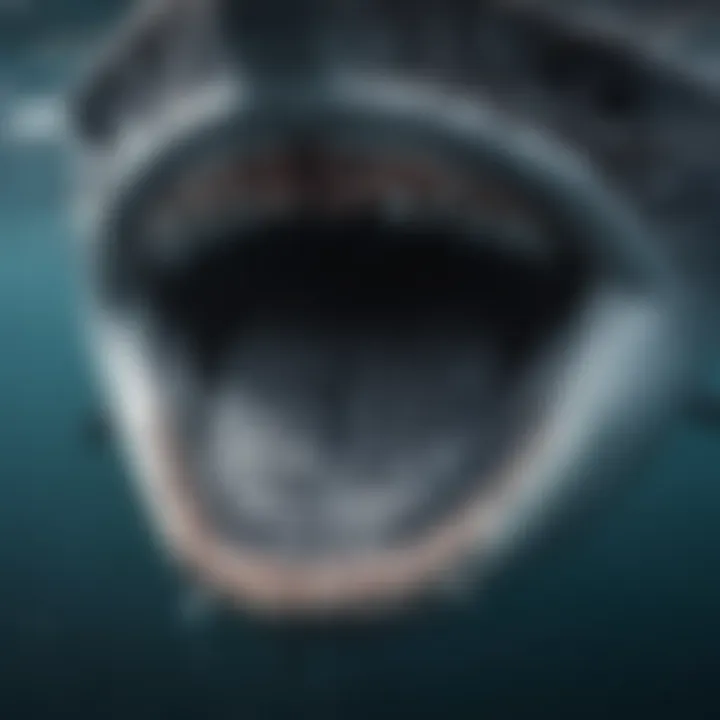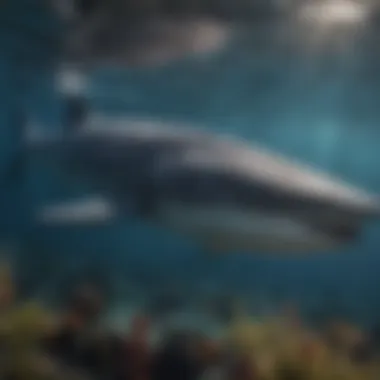The Diet of a Whale Shark: A Comprehensive Exploration


Nature Topic Overview
Whale sharks are the largest fish in the ocean, but they are known for their gentle nature. Understanding their diet is crucial to grasp their role in marine environments. Whale sharks primarily consume plankton, small fish, and other tiny aquatic creatures. This article examines their feeding mechanisms, dietary preferences, and ecological significance. We will explore their unique filter-feeding habits and the challenges they face in their ecosystem. This exploration aims to foster appreciation and awareness among young readers, highlighting why these magnificent creatures deserve our protection.
Fun Facts and Trivia
Here are some intriguing facts about whale sharks:
- Size Matters: Whale sharks can grow up to 40 feet long, but some reports suggest even larger specimens exist.
- Gentle Giants: Despite their massive size, they are not dangerous to humans. They are often described as "gentle giants."
- Slow Movers: They swim at a leisurely pace, usually around 3 miles per hour, allowing them to filter feed effectively.
- Cool Camouflage: Their unique skin patterns are as distinct as human fingerprints, allowing researchers to identify individual sharks.
Wildlife Explorations
Whale sharks are unique, but they share their habitat with various species. Here are some related marine animals:
- Manta Rays: Like whale sharks, manta rays are filter feeders and play a crucial role in their ecosystems.
- Small Fish Species: Schools of small fish, like sardines, often accompany whale sharks, providing them food opportunities.
Every creature in the ocean helps maintain a delicate balance. Moreover, each organism, big or small, has a role within marine ecosystems.
Environmental Awareness
Conservation is vital for the future of whale sharks. They face challenges such as fishing, habitat loss, and climate change. Here are steps to promote sustainability:
- Educate Others: Sharing knowledge about whale sharks helps increase awareness.
- Avoid Products from Unsustainable Fishing: Making informed choices can reduce demand for harmful practices.
- Support Conservation Groups: Donating or volunteering increases efforts to protect these species.
Children can also help protect nature by:
- Participating in beach clean-ups.
- Reducing plastic use.
- Learning about marine life.
DIY Nature Activities
Here are a few fun DIY activities and experiments related to whale sharks:
- Create a Whale Shark Model: Using recycled materials, kids can build a model of a whale shark. This is a great way to learn about their size and shape.
- Plankton Experiment: Under adult supervision, observe tiny creatures in water to understand what whale sharks eat. You could use a simple fish net and look at ponds.
- Nature Journaling: Encourage children to keep a journal of marine life they learn about. They can sketch animals and write interesting facts.
These activities allow kids to explore marine life closely and develop a sense of connection with nature.
Prolusion to Whale Sharks
Whale sharks are the largest fish in the ocean, but their massive size does not impede their gentle nature. Understanding these creatures helps us appreciate the intricate roles they play in marine ecosystems. This section highlights their basic characteristics and the significance of their diet
Basic Information
Whale sharks are unique due to their large dimensions, reaching lengths of up to 40 feet or more. They are easily recognizable with their distinct spots and stripes on a grayish-blue body. Found in warm waters, they often inhabit coastal areas and open oceans. Whale sharks are solitary animals, but they can be seen in groups during feeding or breeding seasons.
Their incredible ability to filter-feed sets them apart from other fish species. As they swim, they take in large amounts of water and expel it through their gills while trapping food particles. This feeding method is essential for their survival and showcases how they are adapted to thrive in their environment.
The Importance of Diet
The diet of the whale shark is crucial for its growth, reproduction, and overall health. These filter feeders primarily eat small organisms, and understanding what they consume sheds light on their ecological role.
"Whale sharks play a vital part in nutrient cycling in the ocean."


Their feeding habits indicate the health of marine ecosystems. By consuming plankton, small fish, and crustaceans, they help regulate these populations, ensuring a balance within their habitats. Moreover, their presence in ocean waters represents a broader health. When whale sharks are thriving, it often means the marine environment is also flourishing.
In summary, the study of whale sharks and their diet provides essential insights into marine life dynamics. These gentle giants illustrate the importance of targeted conservation efforts and highlight how delicate ecosystems can be maintained. Understanding their feeding behavior and dietary needs is a step toward protecting these remarkable creatures.
Anatomy of Feeding
Understanding the anatomy of feeding in whale sharks is crucial for comprehending how these magnificent creatures sustain themselves. Their specialized body structures are finely adapted for their filter-feeding lifestyle, enabling them to efficiently consume vast amounts of food. This section delves into the intricate details of whale sharks' mouth structure and the essential functions of their gill rakers, which work together to facilitate their unique feeding mechanism.
Mouth Structure
The mouth of a whale shark is one of the most distinctive features of this species. Located at the front of the head, it can stretch more than 1.5 meters wide. This wide mouth is not just for show; it plays a vital role in their feeding strategy.
When the whale shark opens its mouth while swimming, water floods in, bringing with it a variety of small organisms like plankton, small fish, and crustaceans. The positioning of the mouth also allows the shark to take in large quantities of water efficiently.
Inside the mouth, there are rows of small teeth and specialized structures known as gill rakers. Although their teeth are not used for biting, they serve an important purpose in filtering the food from the water. The mouth structure is essential for the whale shark's survival in marine environments where food can be scarce. By having a large mouth that can capture significant volume, these gentle giants can maximize their feeding during foraging.
Gill Rakers Function
Gill rakers are integral to the feeding process of whale sharks. These are comb-like structures found along the gill arches. Their primary function is to filter out prey from the water that enters through the whale shark's mouth.
When the whale shark swims with its mouth open, water enters and passes over the gill rakers before it exits through the gills. As the water flows, the gill rakers trap tiny organisms. This allows whale sharks to selectively sift out the food they need while expelling excess water.
The efficiency of gill rakers directly impacts the whale shark's ability to obtain sufficient nutrition. A whale shark can consume up to 6,000 liters of water per hour, resulting in a substantial intake of food. This filtration mechanism reflects an adaptation to their environment, showcasing how anatomical features support dietary needs.
Whale sharks rely on their unique mouth structure and gill rakers, which enable them to filter feed effectively and gather necessary nutrition in vast oceans.
In summary, the anatomy of feeding in whale sharks is a fascinating aspect of their biology. The combination of their expansive mouth structure and specialized gill rakers forms a highly effective feeding apparatus that enables them to thrive in marine ecosystems.
Feeding Mechanism
Understanding the feeding mechanism of whale sharks is crucial in appreciating their ecological role. Whale sharks are remarkable creatures that have evolved unique methods to gather their food. Their feeding techniques not only ensure their survival but also significantly contribute to the health of marine ecosystems. The way these giant fish feed impacts other marine life and helps maintain a balanced environment.
Filter-Feeding
Whale sharks are known as filter feeders. This means they consume food by filtering small organisms from the water. They open their large mouths while swimming, allowing water to flow in. As the water enters, it passes through specialized structures called gill rakers.
- Gill Rakers: These are comb-like structures that trap prey while allowing excess water to exit.
- Food Collection: Mainly, whale sharks eat tiny creatures like plankton, small fish, and crustaceans. By filtering the water, they can catch thousands of these organisms in one mouthful.
This method of feeding is energy-efficient. It allows whale sharks to sustain themselves on relatively small prey. Moreover, this technique is essential for linking the primary production of phytoplankton to higher levels in the food chain.
Whale sharks can consume up to 2,000 kilograms of food each day during feeding periods.
Swimming Technique
The swimming technique of whale sharks is another important aspect of their feeding behavior. These animals glide through the water with a slow and deliberate motion. Their unique swimming style enhances their ability to feed effectively.
- Cruising: Whale sharks often swim at a constant speed, which makes it easier for them to filter feed. When approaching an area rich in plankton, they may increase speed slightly to take advantage of the abundance of food.
- Buoyancy Control: These sharks use their large size and buoyancy to maintain their position in the water column, allowing them to maximize their feeding times without expending too much energy.
This efficient swimming and feeding mechanism allows whale sharks to thrive in various marine environments. Their ability to adapt their swimming techniques to different conditions helps them locate food more easily.
Dietary Preferences
Understanding the dietary preferences of whale sharks is critical for appreciating their role in marine ecosystems. These dietary choices highlight the feeding strategies employed by these large creatures and their significance in maintaining the balance within their habitat. Whale sharks primarily consume plankton, small fish, and crustaceans, providing insights into their unique adaptations and ecological impact.


Primary Food Sources
Plankton
Plankton forms the basis of the whale shark's diet. This microscopic life is abundant in ocean waters and serves as a crucial food source. There are two main types of plankton: phytoplankton, which are tiny plants, and zooplankton, which include small animals. Phytoplankton is vital as it contributes to oxygen production in the sea, forming the foundation of the marine food web. Whale sharks typically filter large amounts of water to consume these microscopic organisms.
Key Characteristic: The sheer abundance of plankton makes it a reliable and easily accessible food source for whale sharks.
Unique Feature: They can consume massive quantities of plankton due to their specialized filter-feeding system. Whale sharks can filter liters of water per minute, trapping these small organisms while swimming.
Advantages: By feeding on plankton, whale sharks play a role in nutrient cycling, ensuring energy flows through the marine ecosystem.
Small Fish
Small fish also form a part of the whale shark's varied diet. Species like anchovies or sardines can often be found in schools, making them an attractive option for these gentle giants. Whale sharks may target these fish during their feeding dives, enjoying a rich source of protein and energy.
Key Characteristic: Their schooling behavior allows for easy targeting by whale sharks when feeding.
Unique Feature: Whale sharks can sometimes be seen circling schools of small fish, using their size and gentle movements to corral and consume large quantities at once.
Advantages: Incorporating small fish into their diet helps whale sharks gain essential nutrients, which are important for their overall health.
Crustaceans
Crustaceans such as shrimp or krill also contribute to the whale shark's dietary habits. Though not as predominant as plankton or small fish, these creatures are essential due to their high nutritional value.
Key Characteristic: Crustaceans are rich in protein and can provide a significant energy source. They are often found in the same habitats as whale sharks.
Unique Feature: Some species of whale sharks adjust their feeding strategies to include crustaceans, especially in areas where these creatures are abundant.
Disadvantage: However, crustaceans can be less abundant than other food sources, making their availability variable, which may limit whale shark feeding in certain regions.
Seasonal Variations
The diet of whale sharks also changes with the seasons. During specific months, certain types of prey become more or less available due to currents, temperature variations, or other environmental factors. This seasonal adaptability ensures that whale sharks can continuously thrive despite changes in food source availability.
Ecological Role
The ecological role of whale sharks is significant in maintaining marine health. As filter feeders, they influence the populations of plankton and small fish. This feeding behavior contributes to the health of the ocean's ecosystems. Whale sharks help regulate species dynamics in their habitats. Their presence ensures that marine environments remain balanced and robust.
Nutrient Cycling
Whale sharks contribute to nutrient cycling in ocean ecosystems. When they filter-feed, they consume a large amount of plankton, which includes microorganisms and nutrients. This process helps redistribute nutrients in the water column. As whale sharks excrete waste, it becomes a source of nutrients for smaller marine life. This action supports the growth of phytoplankton and other organisms, which are crucial for underwater ecosystems. The cycle continues as these organisms provide food for various sea creatures.
Whale sharks play a vital role in nutrient cycling, ultimately supporting the health of coral reefs and other marine habitats.
Influence on Marine Life
The influence of whale sharks extends beyond nutrient cycling. They serve as indicators of ocean health. Because they are vulnerable to changes in their environment, their population trends can signal shifts in marine ecosystems. When whale shark numbers decline, it can indicate issues like overfishing or habitat degradation. Their presence can also enhance biodiversity. For example, the areas where whale sharks feed often attract various species of fish and marine organisms. This interaction promotes a diverse marine life community.
In summary, the ecological role of whale sharks is essential for the health and balance of marine ecosystems. They facilitate nutrient cycling and significantly influence marine biodiversity. Understanding these aspects can help in efforts to conserve these gentle giants and their habitats.
Challenges to Their Diet


Understanding the challenges faced by whale sharks is essential for comprehending their role within marine ecosystems. These majestic creatures rely heavily on specific food sources and habitat conditions for survival. Therefore, factors that disrupt their diet can have severe implications not only for the whale sharks themselves but also for the broader ecological balance.
Overfishing and Habitat Loss
Whale sharks face significant threats from overfishing and habitat destruction. Overfishing occurs when fish populations are depleted faster than they can reproduce. This not only affects the primary food supply of whale sharks, which includes plankton and small fish, but also damages the complex food webs in which they play a role.
In many regions, the fishing of smaller fish can directly reduce their availability to whale sharks. Small fish are often caught indiscriminately through harmful fishing practices. Additionally, the nets used can entangle whale sharks, leading to injury or death. Habitat loss is another pressing issue. Coastal developments, pollution, and climate change contribute to the degradation of vital feeding grounds. The destruction of coral reefs and mangroves can lead to a decrease in biodiversity, robbing whale sharks of their essential food sources.
"Protecting whale shark feeding habitats is critical for their survival and for the balance of marine ecosystems."
Climate Change Effects
The impact of climate change on whale sharks cannot be overlooked. Rising sea temperatures affect the distribution of plankton and other small organisms that whale sharks rely on for food. Changes in ocean temperatures can lead to shifts in the abundance and composition of plankton communities, altering the feeding patterns of whale sharks. Additionally, increased ocean acidification, driven by climate change, threatens marine life and habitats.
Changes in migratory patterns due to altered ocean currents can also disrupt the availability of preferred feeding areas. Furthermore, extreme weather events, a consequence of climate change, can result in habitat destruction and affect the overall health of marine ecosystems.
In summary, the challenges to the diet of whale sharks are multi-faceted. Both overfishing and climate change pose serious threats. Conservation efforts need to focus on protecting their feeding grounds and fostering sustainable fishing practices to ensure the survival of these gentle giants.
Conservation Efforts
Conservation efforts are crucial in ensuring the survival of whale sharks. As their habitats face various threats, understanding how to protect these gentle giants is vital. Whale sharks, being filter feeders, are particularly sensitive to the changes in their environment. Their feeding grounds, where they find abundant plankton and small fish, can be disrupted by pollution, overfishing, and climate change.
Efforts to conserve whale sharks include identifying key habitats essential for feeding and breeding. Protecting these sites means safeguarding the food sources that sustain them. Enhancing awareness about their dietary needs can motivate communities and governments to implement protective measures. Conservation provides benefits not only to the shark but also to the entire marine ecosystem. A balanced ecosystem contributes to biodiversity, which is beneficial for all species, including humans.
"If we protect whale sharks, we also protect many other marine species that share their habitat."
Protecting Feeding Grounds
Feeding grounds are essential for whale sharks. These areas are often rich in plankton, attracting them for nourishment. Conservation strategies focus on safeguarding these locations from harmful activities. Designating marine protected areas can restrict fishing and limit pollution. This not only helps whale sharks but encourages a healthier ecosystem overall.
Local communities can contribute by monitoring these areas, ensuring that any harmful practices, like illegal fishing or dumping waste, are minimized. Education plays a key role here. Younger generations can learn about the importance of preserving marine life, promoting a culture of conservation. Involving local schools in wildlife protection initiatives fosters a deeper understanding and commitment to these efforts.
Global Initiatives
Global initiatives play a significant role in the conservation of whale sharks. Various organizations like the Shark Trust and Project AWARE aim to increase global awareness and action for shark protection. These programs work to gather data, educate the public, and advocate for policies that ensure the survival of whale sharks.
Research plays a central role in these initiatives. Scientists study migration patterns, feeding habits, and reproduction to better understand whale sharks’ needs. This information informs better conservation practices, helping to align local efforts with global strategies.
Collaboration is essential. Countries around the world connect to form networks sharing best practices in whale shark conservation. Such partnerships can amplify the impact of local efforts, enabling a larger scope of protection for the species.
By supporting global initiatives, individuals and organizations can contribute to the cause of whale shark conservation. Each action taken can lead to positive outcomes, ensuring that future generations can continue to marvel at these magnificent creatures.
Ending
The conclusion holds vital importance in wrapping up the discussions presented in this article. It synthesizes key elements of the whale shark's diet, summarizing how their feeding habits shape their ecological role in the marine environment. Understanding these connections enhances our knowledge of marine ecosystems at large, particularly how large filter-feeders like whale sharks contribute to nutrient cycling and biodiversity. In this section, we will recap the most crucial aspects of their diet and note the ongoing efforts needed to maintain their populations and habitats.
Recap of Dietary Importance
Whale sharks primarily feed on plankton, small fish, and crustaceans. Their unique filter-feeding technique allows them to consume vast amounts of food while swimming through the water. This not only supports their own health and growth but also keeps plankton populations in check, contributing to a balanced ecosystem. Given that whale sharks filter and consume a variety of marine organisms, they serve a key role in the food web, affecting species composition.
The dietary habits of whale sharks highlight their importance in marine life, as they optimize the energy flow and nutrient cycling. They transport nutrients they ingest throughout the ocean, and thus help to support a network of species from the smallest plankton to larger marine animals.
Future Research Needs
Despite the existing research on whale sharks, there are still many gaps in our understanding. Future research should focus on the following areas:
- Habitat Requirements: More studies are needed to understand where whale sharks feed and reproduce. Identifying critical habitats can help guide conservation efforts.
- Impact of Climate Change: As ocean conditions change, understanding how whale sharks respond to these influences is crucial.
- Diet Variability: Researchers need to investigate how whale sharks adapt their diets in different geographic regions or seasonal changes. This can inform us about their adaptability and resilience.
Addressing these research needs will not only enhance our comprehension of whale sharks but also highlight their broader implications for marine conservation and management strategies.
In summary, whale sharks are remarkable creatures whose diets reflect their fundamental role as filter feeders in marine ecosystems. Educating the public about their dietary habits increases awareness about the necessity of conservation. Protecting these gentle giants ensures the health of our oceans, benefiting diverse marine life.







